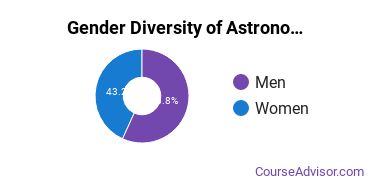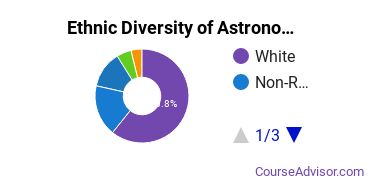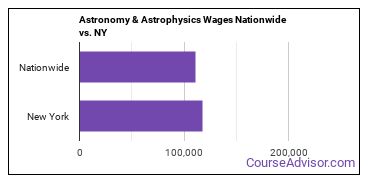Astronomy Schools in New York
95 Astronomy students earned their degrees in the state in 2022-2023.
In this state, Astronomy is the 222nd most popular major out of a total 336 majors commonly available.
Education Levels of Astronomy Majors in New York
Astronomy majors in the state tend to have the following degree levels:
| Education Level | Number of Grads |
|---|---|
| Bachelor’s Degree | 49 |
| Master’s Degree | 23 |
| Doctor’s Degree (Research / Scholarship) | 13 |
| Doctor’s Degree (Professional Practice) | 13 |
| Doctor’s Degree (Other) | 13 |
| Post-Master’s Certificate | 10 |
| Postbaccalaureate Certificate | 10 |
Gender Distribution
In New York, a astronomy major is more popular with men than with women.

Racial Distribution
The racial distribution of astronomy majors in New York is as follows:
- Asian: 7.4%
- Black or African American: 3.2%
- Hispanic or Latino: 7.4%
- White: 51.6%
- Non-Resident Alien: 20.0%
- Other Races: 10.5%

Jobs for Astronomy Grads in New York
In this state, there are 4,620 people employed in jobs related to an astronomy degree, compared to 104,790 nationwide.

Wages for Astronomy Jobs in New York
A typical salary for a astronomy grad in the state is $117,370, compared to a typical salary of $111,090 nationwide.

Most Popular Astronomy Programs in NY
There are 10 colleges in New York that offer astronomy degrees. Learn about the most popular 10 below:
The student to faculty ratio is 6 to 1. 57% of students get financical aid. An average student at Columbia will pay a net price of $23,497.
Request InformationOf all the teachers who work at the school, 91% are considered full time. An average student at Cornell will pay a net price of $29,651. 59% of students are awarded financial aid at this school.
Request Information88% of students get financical aid. Of all the teachers who work at the school, 63% are considered full time. This public school has an average net price of $17,232.
Request InformationSeeking financial aid? At this school, 99% of students receive it. Of all the teachers who work at the school, 69% are considered full time. The average student takes 4.76 years to complete their degree at RIT.
Request InformationStudents enjoy a student to faculty ratio of 16 to 1. Seeking financial aid? At this school, 99% of students receive it. Of all the teachers who work at the school, 51% are considered full time.
Request InformationMost students complete their degree in 4.05 years. An average student at Colgate will pay a net price of $24,052. Students enjoy a student to faculty ratio of 9 to 1.
Request Information64% of students are awarded financial aid at this school. Students enjoy a student to faculty ratio of 7 to 1. The average student takes 4.06 years to complete their degree at Vassar.
Request InformationThe student to faculty ratio is 10 to 1. 53% of students get financical aid. 100% of the teachers are full time.
Request InformationIt takes the average student 4.24 years to graduate. Of all the teachers who work at the school, 86% are considered full time. The student to faculty ratio is 12 to 1.
Request Information94% of students get financical aid. Of all the teachers who work at the school, 91% are considered full time. This private school has an average net price of $35,375.
Request InformationAstronomy Careers in NY
Some of the careers astronomy majors go into include:
| Job Title | NY Job Growth | NY Median Salary |
|---|---|---|
| Atmospheric, Earth, Marine, and Space Sciences Professors | 17% | $97,390 |
Related Majors in New York
Below are some popular majors in the state that are similar to astronomy.
| Major | Annual Graduates in NY |
|---|---|
| Chemistry | 1,421 |
| Physics | 1,121 |
| General Physical Sciences | 984 |
| Geological & Earth Sciences | 573 |
| Other Physical Science | 214 |
| Materials Sciences | 96 |
| Atmospheric Sciences | 61 |
View all majors related to Astronomy
Explore Major by State
Alabama
Arkansas
Connecticut
Florida
Idaho
Iowa
Louisiana
Massachusetts
Mississippi
Nebraska
New Jersey
North Carolina
Oklahoma
Rhode Island
Tennessee
Vermont
West Virginia
View Nationwide Astronomy Report
References
More about our data sources and methodologies.










